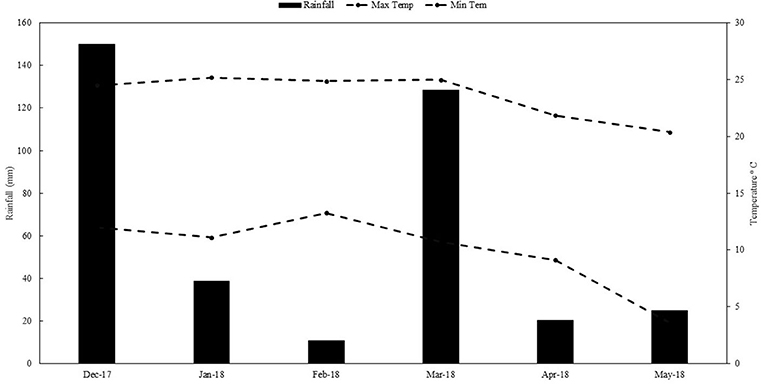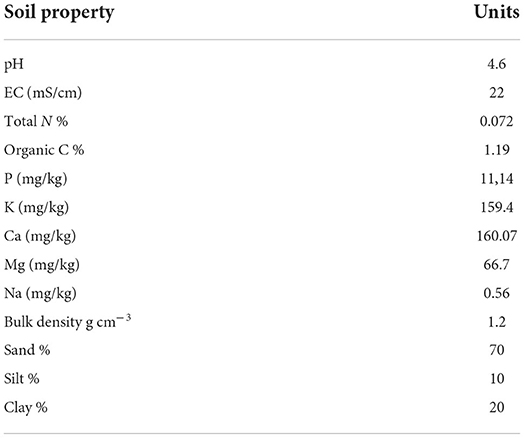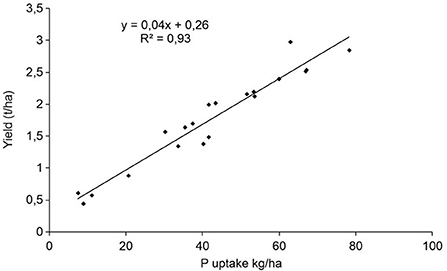- 1Agricultural Research Council – Natural Resources and Engineering, Pretoria, South Africa
- 2Department of Agriculture and Animal Health, University of South Africa, Roodepoort, South Africa
- 3KCA University, Nairobi, Kenya
- 4School of Agricultural, Earth and Environmental Sciences, University of KwaZulu Natal, Durban, South Africa
- 5Department of Agriculture, Land Reform and Rural Development, Pretoria, South Africa
Some of the limiting factors for smallholder farmer soybean production in South Africa are low native soil phosphorus (P) availability and poor utilization efficiency of added P. Phosphorus fertilization, use of improved or high yield potential cultivars and appropriate cropping systems could increase soybean yields. The objective of this study was to determine the effects of tillage, cultivar and P fertilization levels on P uptake and P use efficiency, as well as plant growth, yield, grain protein and oil content, in a soybean based cropping system. The study was conducted under dryland conditions at Sheepmoor, Mpumalanga. A field experiment was established in a randomized complete block design. Treatments were arranged in a 2 × 3 × 3 strip-split-plot structure. There were two tillage systems [no-till (NT) and conventional tillage (CT)], three cultivars (PAN 1614R, PAN 1521R, and PAN 1532R), and three phosphorus rates (0, 30, and 60 kg/ha). All treatment combinations were replicated three times. P uptake improved with P application, although there were no differences between 30 and 60 kg/ha whilst PFP was significantly higher at 30 kg/ha P. Yield was significantly higher at 30 kg/ha P application under NT and varied with cultivars. P application at 30 and 60 kg/ha significantly reduced oil content by 11.3 and 7.16%, respectively, but had inverse effects on protein content. The activities of acid phosphatase (ACP) and alkaline phosphatase (ALP) also increased with P application. Improvement of soybean yield and its attributes, grain quality, P uptake, PFP, soil physicochemical and microbial properties emphasize the importance of fertilizer application, sustainable cropping systems coupled with careful cultivar selection. Therefore, in order to improve soil fertility and soybean yield under small farm conditions, the application of no-till and optimum application of fertilizers should be prioritized.
Introduction
A major limiting factor for soybean production in South Africa is low soil phosphorus (P) availability together with inefficient utilization of added P (Mabapa et al., 2010; Roberts and Johnston, 2015). Compounding this are the risks of crop failure posed by climate change (Mall et al., 2017; Mohanty et al., 2017). Despite these challenges, soybean is the world's most traded oil seed and has the potential of being Africa's Cinderella crop (Kolawole, 2012; Lee et al., 2016). The demand for soybean is very high and increasing with the increasing population (Dlamini et al., 2013; Phiri et al., 2016; Ronner et al., 2016), however, yield is still fixed at an average of 1.1 t/ha for decades (Khojely et al., 2018). In South Africa, soybean is one of the country's main commodities and its production, promotion and processing has gained some priority in the country's industrial plans since 2010 (Dlamini et al., 2013). The area under soybean production has relatively increased to about 800,000 ha since 1903 when the crop was initially introduced to South Africa (Khojely et al., 2018; DALRRD, 2020), however, average yields are still lower than experimental yields due to drier climate and low fertility soils (Phiri et al., 2016; Ronner et al., 2016; Sithole et al., 2016). For optimal yields, soybean requires between 15 and 18 mg/kg P in the soil (FERTASA, 2016). However, most soils in smallholder farming areas in South Africa are low in available P, averaging <10 mg/kg Bray 1 (Nziguheba et al., 2016).
Phosphorus is the most crucial nutrient for soybean due to its fundamental role in root establishment, grain formation and enhancement of vegetative growth (Chien et al., 2011; Shen et al., 2011). It also regulates various enzymatic activities, required for energy intensive processes in root nodule and N-fixation (van de Wiel et al., 2016; Liu et al., 2018; Mitran et al., 2018). Phosphorus also promotes higher yield and better grain quality (Mokoena, 2013). Significant positive correlations between the crop's P uptake and seed yield on soybean has been reported (Abbasi et al., 2010). According to Zheng et al. (2010), phosphorus availability could also improve root morphology even when water deficiencies occurred at reproductive stage. Phosphorus also improves plant biomass and increases P utilization efficiency (Abbasi et al., 2010). Therefore, enhancing P utilization efficiency is vital in improving crop yields and reducing eutrophication risks (Hasan et al., 2016; Heuer et al., 2017). However, the utilization efficiency is affected by factors such as, P availability, P fertilization rate and seed genotype (Syers et al., 2008; Mitran et al., 2018). A research report by Dalshad et al. (2013) from an experiment conducted at the University of Salahaddin/Erbil in Iraq, showed increased P plant uptake by 99–280.49% on various soybean cultivars after application of superphosphate at 75 kg/ha. Furthermore, one of the cultivars used, cultivar 44NK, recorded an increase of up to 10.08 and 55.56% on phosphorus fertilizer use efficiency (FEP) as well as physiological phosphorus use efficiency (PUEp), respectively. Abbasi et al. (2010) after observing an increased P uptake with soybean, also noted that as P rates increased P-use efficiency decreased, and therefore concluded that the low recovery efficiency could be a result of high P fixation rate by Ca compounds or Fe/Al oxides.
Fixation of P is a common challenge in many agricultural soils (Shanker and Shailendra, 2014). Although phosphorus may be abundant in many soils with a range of 100–2,000 mg/kg soil, representing nearly 350–7,000 kg/ha P in the top 25 cm layer of soil (depending on parent material, soil texture, vegetation cover and soil management history), ~50% of the world's productive lands are deficient in P (Grant et al., 2005; Owen et al., 2015; Heuer et al., 2017). Furthermore, about 30% of global soils have a high P-fixation capacity (van de Wiel et al., 2016; Menezes-Blackburn et al., 2018). Consequently, even when phosphorus is available in large quantities in the soil, ~80% is unavailable to the plant immediately after application (Roberts and Johnston, 2015; Zhu et al., 2018), because <0.1 % is in orthophosphate form, which plants can easily uptake (Raliya et al., 2016; Garland et al., 2018). Recent studies, however, do not support the general perception of fixation of all soil residual phosphorus (Roberts and Johnston, 2015; Zhu et al., 2018; Yan et al., 2020). Syers et al. (2008) proposed that inorganic phosphorus in the soil moves through four different P pools that vary in availability. The four main pools are (1) P in soil solution, (2) surface absorbed P, (3) strongly bonded or absorbed P, and (4) very strongly bonded or precipitated P. The first two pools contain readily available and extractable P with the first pool having immediately available P for plant use. The last two pools contain P that is not readily available. The availability of P depends on the amount accessible to plant roots. Standard laboratory methods such as Bray, Mehlich and Olsen are often used to measure soluble P, which act as indices of available P, however, the extractants do not measure the P transformed in fixed forms.
There are of a number of P activators for improving soil available P. These include phosphate solubilizing microorganisms (PSM's), phosphatase enzymes and enzyme activators (Satyaprakash et al., 2017; Zhu et al., 2018). Acid and alkaline phosphatases are the most abundant enzymes involved in solubilizing organic P compounds. These can be easily detected due to their sensitivity to disturbance (Balota et al., 2004). Phosphatases play a role in mobilizing soil P and reallocating a plant's internal P (van de Wiel et al., 2016). Nonetheless, soil biological as well as physicochemical factors such as OM, pH, nutrients, and microorganisms affect their activities (Piotrowska-Dlugosz and Wilczewski, 2014). Phosphatases highly correlate with organic matter and some studies reported significantly high activities of Acid Phosphatase (ACP) and Alkaline phosphatase (ALP) following manure or compost application (Mohammadi, 2011; Zhu et al., 2018). Heidari et al. (2016) noted an improvement in ACP, ALP, and Dehydrogenase activities by up to 90, 60, and 148% on a treatment that had a combination of farmyard manure and compost as compared to control, which had zero fertilizer. This further supports that organic inputs improve soil microbial activities and increase microbial biomass (Heidari et al., 2016). Moreover, soil organic matter acts as an organic medium for soil enzymes (Lemanowicz et al., 2016). Mineral fertilizers also have effects on phosphatase activity; nonetheless, contrasting results have been reported. Some authors have reported an increase in phosphatase activities following fertilization, and some reported the opposite. Chen et al. (2018) reported the highest activities of phosphatase from a treatment that had a combination of P, K, and N fertilizer at 39, 112, and 276 kg/ha respectively, from a study with six fertilizer treatments conducted in China. The six treatments were as follows: CK—soil without fertilizer; N1—low N fertilizer; N2—high N fertilizer; N2P—N2 fertilizer and P; N2K—N2 fertilizer and K; N2PK—N2 fertilizer, P and K. 138 kg N/ha and 276 kg N/ha was applied in N1 and N2 treatments, respectively. 39 kg P/ha and 112 kg K/ha was applied in the N2PK treatment. However, Zhang et al. (2015), noted a significant decrease of ACP activities at a range between 11 and 63% following application of 59 and 88 kg/ha of NPK mineral fertilizer, respectively.
An intervention being advocated for enhancing soil and water productivity in cultivated areas is no till. This is due to its cost effectiveness, environmental sustainability and efficient in P conservation and cycling (Moraru and Rusu, 2013; Ramesh et al., 2014). Promoting practices such as no-till, which improve soil aggregate stability and hence soil organic carbon concentrations within the aggregates could also increase availability of phosphorus in smallholder arable lands (Busari et al., 2015). No-till increases micro-organisms' diversity (Vukicevich et al., 2016) and also increases and stratifies soil enzymatic activities (Bowles et al., 2014; Rincon-Florez et al., 2016), probably resulting from increases in organic matter and microbial activity (Sithole et al., 2016).
There is enormous literature on soil P dynamics and crop responses to phosphorus fertilization, however in South Africa (SA), the effects of P fertilization on soybean under no-till is still lacking. Moreover, most of the studies were carried out on experimental farms rather than smallholder farmer's fields. Blanket recommendations for fertilizer applications have been made, however they may not meet the requirements of a small farm specific needs (Mabapa et al., 2010). Furthermore there is limited research on no-till practices and P dynamics especially within smallholder production farms with acidic soils in SA. According to Sithole et al. (2016), the adoption rate for conservation agriculture practices such as no-till stands at 2.8% on the total country's agricultural land. Therefore, this study aimed to determine the availability and utilization efficiency of soil P to maximize soybean yields under no-till.
Materials and methods
Site description
The study was conducted in Sheepmoor, Mpumalanga. The farm is situated at 26°45″18′S, 30°13″58′E at an altitude of 1,537 m in Gert Sibande District Municipality, ~45 km from Ermelo town. Sheepmoor is described as temperate dry winter and warm summer. Average rainfall is about 756 mm per annum. Minimum temperatures are between 7 and 8°C and maximum temperatures are between 26 and 30°C. Soils of the study site are sandy loam with a strongly acidic pH of 4.6. The particle size analysis indicated the soils had 20% clay, 10% silt, and 70% sand in 0–30 cm depth. Soil available P was 11.14 mg/kg, which according to FERTASA (2016) is low for soybean production and justifies the need for P amendments. The soil also had lower concentrations of soil exchangeable Ca, Mg, and K, which were 160.07, 66, and 159.4 mg/kg, respectively. Organic C and total N were 1.19 and 0.072%.
Experimental design
A randomized complete block design (RCBD) arranged in a 2 × 3 × 3 strip-split-plot layout was used to study the availability of soil P and utilization efficiency of added P in a soybean cropping system. The treatments were composed of two tillage systems, No-till (NT) and Conventional tillage (CT) as main plots (vertical rows), three soybean cultivars (PAN 1532R; PAN 1521R; and PAN 1614R) as sub plots (horizontal rows) and three Phosphorus fertilizer rates (0, 30, and 60 kg/ha) as sub-sub plots (intersection plots) replicated three times to give 54 plots. Phosphorus fertilizer source used was Monoammonium phosphate (MAP). Fertilizer was applied by banding at 5–7 cm away from the seed furrow. Each plot consisted of six 7 m long soybean rows with an inter and intra-row spacing of 60 and 5 cm, respectively (gross plots), targeting a population of 300,000 plants per hectare. The net plots consisted of four middle rows of the gross plots. The three soybean cultivars were selected based on performance in a preliminary study conducted by the ARC-SCW at the study site. The use of three soybean was done in order to determine possible differences in growth, productivity and P-use efficiency as influenced by contrasting soybean varieties.
Trial management
After trial demarcation, conventional tillage was done using a tractor-drawn mouldboard plow. Plots demarcated for no-till were treated with N-[phosphono-methyl] glycine, 360 g L-1 (Roundup) at a rate of 4 L per hectare to eradicate weeds; before planting and throughout the season. Weeds were eradicated through direct application using a knapsack sprayer to avoid contact with main crop. Furrows for direct seeding were created using hand hoes and seeds were placed manually in the furrows using a marked row after direct fertilization had been done at ratios explained on Section Experimental design. Scouting for pests and diseases was done every second week during the growing season, however, no agro chemicals were administered as there were no diseases and harmful pests observed.
Sampling and data collection
Prior to establishment of experiments, three composite soil samples from five sub samples per block were collected randomly at a depth of 0–30 cm in October 2016. Samples were air dried and passed through a 2 mm sieve and then used for initial soil characterization (SSSSA. Non-Affiliated Soil Analysis Work Committee, 1990). To evaluate the effects of treatments on soils, three sub-samples samples were randomly taken per plot with an auger at the 30 cm depth after harvest in July 2018. The following parameters were analyzed: soil solution pH was measured in water at a 1:2.5 soil water ratio as described by Okalebo et al. (2002) using a pH meter. The same suspension was used to measure electrical conductivity (EC) after allowing them to settle for 1 h using an EC meter (SSSSA. Non-Affiliated Soil Analysis Work Committee, 1990). Total N was determined using the dry combustion method using the Flash 2000 CHNS-O Analyzer. Phosphorus was extracted by P-bray 1 solution and analyzed with a flow analyzer, (SSSSA. Non-Affiliated Soil Analysis Work Committee, 1990). K+, Ca2+, Na+, and Mg2+ were extracted with ammonium acetate solution and analyzed with an Induced Coupled Plasma (ICP-OES). Fe was extracted with HCl and analyzed with ICP. Al was determined through titrable acidity method using sodium hydroxide (SSSSA. Non-Affiliated Soil Analysis Work Committee, 1990).
Bulk density was determined using the core method as described by Bonin and Lal (2012). Three random samples were collected from each plot using a core sampler. The samples were weighed immediately after collection and later transported to the laboratory for drying. Samples were oven dried for 24 h at 105°C and then weighed again. Bulk density was then calculated as the ratio of mass of dry soil per unit volume of soil cores. Penetration resistance was randomly measured from five points in a plot using a push-cone penetrometer with a measuring range of 0–40 mm. The penetrometer measured a resistance of soil by pushing a cone vertically into the profile. Activities of acid and alkaline phosphatase were evaluated as described by Tabatabai (1994). These enzyme activities were analyzed using 1 g of air-dried soil in a 50-ml Erlenmeyer flask with their appropriate substrate and incubated for 1 h (37°C) at their optimal pH (pH 6.5 for assay of acid phosphatase or pH 11 for assay of alkaline phosphatase). Enzyme activities were evaluated in duplicate with one control, to which, substrate was added after incubation and subtracted from the sample value.
A measuring stick was used to measure plant height during crop maturity by measuring crop length from base to the top leaf. Days to 50% flowering were recorded as the day on which half the crops in each plot flowered. The number of pods per plant (NPP), pod length and number of seeds per pod were counted manually from three plants randomly selected from the net plots at crop maturity. The maturity date was recorded when the crops had turned golden yellow. Soybean net plots were harvested manually into grain bags; grain weight was measured with a digital scale after shelling. Three plants from boundary rows were used to measure wet shoot biomass with a digital scale and then taken to the laboratory for dry biomass measurements after oven drying the samples for 24 h at 70°C. A moisture meter (Dramiński Twistgrain) was used to measure grain moisture at harvest according to the instrument's instruction manual. 100-seed weight was measured by counting 100 seeds and then weighing them on a digital scale. Grain protein and oil content were measured by DA 7250 NIR analyzer (Perten Instruments, Hägersten, Sweden) following a non-disruptive method as stipulated in the instruction manual of the instrument. The sample was poured into an open-faced dish and placed in the machine. Results were viewed on the screen of the machine. Yield was calculated using the following equation and expressed in tons per hectare:
Where 12% is the adjusted moisture (Verde et al., 2013).
Plant N was analyzed using the dry oxidation method on a Flash 2000 CHNS-O Analyzer whilst P and K were analyzed following digestion with Nitric + Perchloric acid on an Agilent 725 (700 Series) Inductively Coupled Plasma Optical Emission Spectrometric (ICP-OES).
P use efficiency was calculated using the balance method as follows:
Partial factor productivity (PFP), which measures the utilization efficiency considering production productivity was determined by dividing yield by amount of P applied. It indicates the productivity of a crop (yield) in comparison to the fertilizer applied Roberts and Johnston (2015).
Statistical analysis
Analysis of variance (ANOVA) and correlations were performed using JMP 14 (Ramirez and Ramírez, 2018). Mean separations were done using Fishers' protected least significant differences (LSD) at P < 0.05. Correlations were performed using Pearson's correlation test.
Results and discussion
Climatic data during the planting season and results from the initial soil characterization are presented in Figure 1 and Table 1, respectively.
Fertilizer and tillage effects on soil properties
Significant effects (P < 0.05) of fertilizer application were observed on exchangeable calcium (Ca) and magnesium (Mg), Iron (Fe), total Nitrogen (TN), exchangeable phosphorus (P), and exchangeable potassium (K) concentrations (Table 2). Application of 30 kg/ha P significantly increased levels of extractable Ca, Mg, K, and TN by up to 61.87, 52.91, 33.12, and 11.59%, respectively, over the control. However, at the 60 kg/ha P rate exchangeable Ca, Mg, K, and TN were statistically lower than those observed after the application of 30 kg/ha P, whereas available P gradually increased up to 97.23% over control, and recorded the highest soil P levels at 60 kg P/ha application rate. On the contrary, application of 30 kg/ha P caused a significant decrease in extractable Fe, whereas at 60 kg/ha, the amount of Fe equivalent to control.

Table 2. Effects of fertilizer, cultivar and tillage on soil physico-chemical properties on a soybean cropping system.
Soil pH was not significantly affected by fertilizer application whilst extractable Aluminum (Al) was not significantly affected by any of the main treatments. Meanwhile, pH, exchangeable Ca, Mg, and K were significantly affected (P < 0.05) by tillage (Figure 5). No-till led to the increase of pH, exchangeable Ca, Mg, and K by up to 1.76, 20.64, 23.77, and 15.08% over CT, respectively. Tillage had no significant effects on Fe, Al, and P (Table 2). Out of the selected physical properties, bulk density (BD) was not affected by any of the main treatments, whereas penetration resistance was significantly affected (P < 0.05) by tillage.
Exchangeable cations such as Ca and Mg are usually low in strongly acidic soils (Fageria and Baligar, 2005). However, the increase of Ca and Mg at 30 kg/ha P could be a result of lower Fe concentration at the same fertilizer rate and vice versa at 60 kg P/ha application. Iron and Aluminum, like many metals, are predominantly found in strongly acidic soils such as the experimental site (Lemanowicz et al., 2016; Heuer et al., 2017). Therefore, significant decrease of Fe at 30 kg/ha P could be due to fixation: Fe/Al oxides fix more than 80% of applied P; this reaction may significantly reduce Fe and available P in the soil solution (Heuer et al., 2017; Zhu et al., 2018). Literature has also shown that Fe uptake by plants is sensitive to excessive P (Murphy et al., 1981); therefore, surplus P may cause inhibition of Fe from plant root uptake, and thus making Fe available at higher concentrations in the soil solution (Murphy et al., 1981; Fageria, 2001).
The increase of TN and a progressive increase of P from 30 to 60 kg/ha in soil solution could be a result of supply of phosphates and ammonia from fertilization (Aniekwe and Mbah, 2014; Zhang et al., 2015; Yin et al., 2016) (Table 2). A significant decrease in TN at 60 kg/ha P as compared to 30 kg/ha P (Table 2) may be a result of plant N uptake, which was significantly higher at 60 kg/ha P (Table 4). This is because adequate supply of P in the roots of soybean increases root biomass and nodulation, which facilitates nitrogen fixation (Mitran et al., 2018).
The increase of exchangeable Ca2+, Mg2+, and K+ under no-till could be due to residue retention (higher organic matter accumulation), which through decomposition, releases nutrients back into the soil (Malecka et al., 2012; Sithole et al., 2016). The increase of both Ca and Mg could be responsible for the increase in pH under NT. Similarly, Busari et al. (2015) noted that increasing tillage disturbance decreases soil surface pH, and that CT shifts top fertile soils into the sub-soil, and the less fertile sub-soils onto the surface. Moreover, due to a loose soil structure under CT, loss of nutrients through erosion is also a possibility.
Lower PR and BD were observed under NT as compared to CT, but only PR was affected significantly (P < 0.05; Table 2). This is because PR is more sensitive to changes than BD (Moraru and Rusu, 2013). However, literature has contrasting reports on PR and BD under no-till. Some studies reported a stable or higher PR and BD on no-till especially at the 0–10 cm layer (Jabro et al., 2011; Malecka et al., 2012; Villamil et al., 2015; Sithole et al., 2016), whilst others observed the opposite (Malecka et al., 2012; Sharma et al., 2016). However, data from some long-term studies indicate a shift on bulk density as years progress. Sharma et al. (2016) observed higher soil BD under NT within the initial 5 years of the experiment, however after 10 years a reverse trend was observed. This makes the duration of the experiment an important factor especially for soil physical characteristics. The lower penetration resistance in the current study could be a result of soil moisture retained under crop residues through higher production of biomass, which ultimately improved soil structure under NT (Bogunovic et al., 2019). The benefit of lower penetration resistance in no-till systems is root elongation, proliferation and plant nutrient uptake (Moraru and Rusu, 2013).
Soil enzyme activities were significantly affected (P < 0.05) by fertilizer and tillage at various growth stages (Table 3). The activities of ACP increased by up to 36% at reproductive stage under no-till as compared to CT. This is because no-till is effective in improving soil enzyme activities in the short-term (Heidari et al., 2016). According to Sithole et al. (2016), the increase in soil enzymes activities under no-till could be a results of the increase in stratification of enzymes close to the soil surface due to increased soil organic matter. Balota et al. (2004) also reported an increase of ACP and ALP up to 46 and 61% at top soil layer under no-till, respectively.
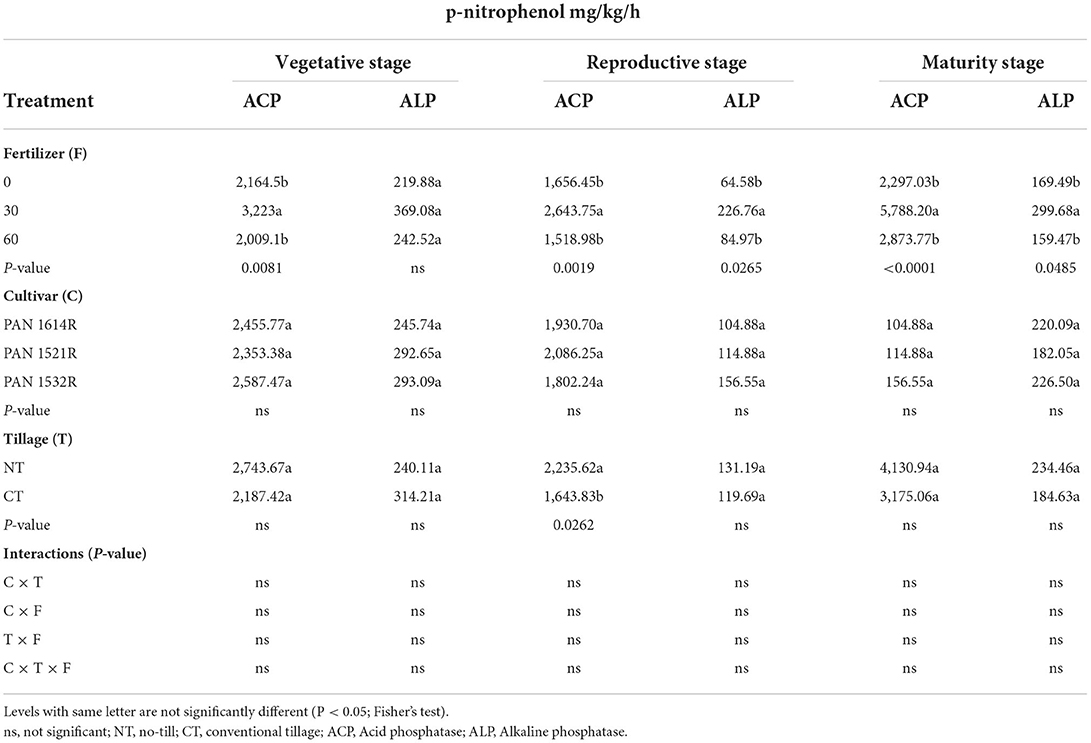
Table 3. Fertilizer application, cultivar and tillage effects on acid phosphatase and alkaline phosphatase activities on a soybean cropping system.
Phosphorus application at 30 kg/ha caused a significant increase of ACP activities by up to 48.93, 59.59, and 151.99% at vegetative, reproductive and maturity stage, respectively, over control. Whereas for AL P, significant increases were only noted during reproductive and maturity stages by up to 251.13 and 76.81%, respectively, over control. The activities of ACP were generally higher than ALP due to the strongly acidic pH. According to Sharma et al. (2013), acid phosphatase are usually the dominant group of enzymes involved in mineralizing P in acidic soils whilst alkaline phosphatase enzymes are dominant in alkaline soils. The difference in enzyme activities were not significant at 60 kg/ha P. Phosphatase activities could have been suppressed by an increase of inorganic phosphorus in the soil because more often, phosphatases activities are inversely proportional to available soil P concentration (Wang et al., 2013; Lemanowicz et al., 2016). Heidari et al. (2016) also reported a suppression of phosphatase activities due to fertilization. This may suggest that P rate up to 30 kg/ha could be the optimum level for high phosphatase activities in the study area.
Plant NPK uptake and P utilization efficiency
Application of P improved uptake of N, P, and K significantly (P < 0.05), however, excessive application of P above 30 kg/ha did not enhance uptake significantly except for N (Table 4). For P and K, the highest uptake was observed at 60 kg/ha P rate, although it was statistically similar to 30 kg/ha P rate. Whereas for N, there was a significant progressive increase at 30 and 60 kg/ha P. Nutrient increases were as follows: at 30 kg/ha P rate, uptake of N, P, and K increased by up to 21.74, 91.51, and 69.05%, whilst at 60 kg/ha P rate the increase was up to 34.78, 119.82, and 75.76%, respectively, over control. Aulakh et al. (2003) and Sharma et al. (2011) also reported increase in nutrient uptake following P application, however, excessive P did not have agronomic benefits such as increase in yield, biomass or biomass partitioning to grain. Findings of the current study confirmed reports from several researchers who argued that nutrient uptake is correlated with biomass production (Sharma et al., 2011; Dalshad et al., 2013; Fageria et al., 2013) (Table 5).
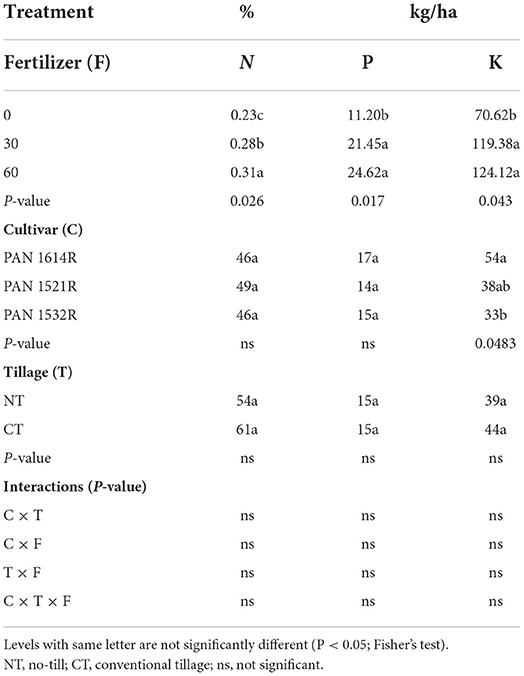
Table 4. Effects of fertilizer, cultivar and tillage on plant nutrient uptake on a soybean cropping system.

Table 5. Pearson's correlation test on plant nutrient uptake (N, P, K) with dry biomass on a soybean cropping system.
Main treatments and their interactions had no significant effects (P < 0.05) on P use efficiency (Table 6). The utilization efficiency at 30 and 60 kg P/ha rate was 19.65 and 15.82%, respectively. This is considered to be a very low utilization efficiency. Usually, a P use efficiency calculated using the balance method should be in the range of 50–70% but can even be higher than 100% if the crop also utilized some of the P reserves in the soil. A very low P utilization efficiency recorded for this study could suggests a high fixation capacity of soils and/or more fertilizer was applied than what was needed for the crop (Roberts and Johnston, 2015). Nonetheless, partial factor productivity (PFP) which only focuses on seed yield indicating crop productivity in relation to its nutrient input was significantly affected (P < 0.05) by P rate. PFP increased by up to 105.79% at 30 kg/ha over 60 kg/ha P. Syers et al. (2008) and Abbasi et al. (2010) reported that as P rate increase P-use efficiency decreased. This therefore means P supply at 60 kg/ha rate exceeded the requirement for optimum crop production (Roberts and Johnston, 2015).
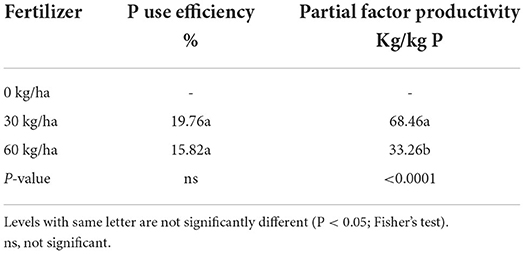
Table 6. Fertilizer effects on P use efficiency and Partial factor productivity on a soybean cropping system.
Fertilizer application, tillage and cultivar effects on soybean growth, yield components, and grain quality
Fertilizer, cultivar and tillage had significant effects on crop growth and yield components (Table 7). Number of pods per plant (NPP) and plant height increased progressively with P application by up to 66.15 and 21.31%, respectively, over control. However, these increases were statistically similar at 30 and 60 kg/ha P. Tillage and cultivar did not have any significant effects (P < 0.05) on NPP, however, cultivar had significant effects on plant height. Tillage did not significantly affect plant height, and in addition, fertilizer and tillage did not significantly affect 100-seed mass and pod length. The 100-seed mass, pod length together with plant height were significantly affected (P < 0.05) by cultivar (Table 7). PAN 1614R recorded the highest 100-seed mass (16.85 g), longest pods (4.11 cm) and tallest plants (49.84 cm). However, for 100-seed weight the cultivars PAN 1614R and PAN 1521R were statistically similar.
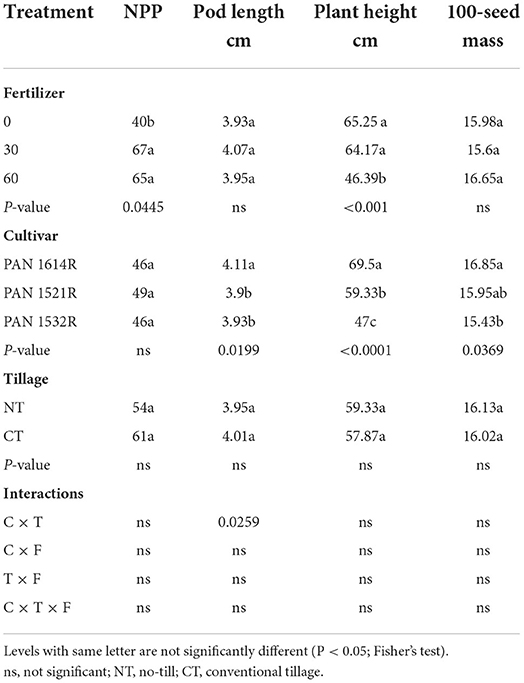
Table 7. Effects of fertilizer, cultivar and tillage on number of pods per plant (NPP), pod length, plant height, and 100- seed mass on a soybean cropping system.
A significant interaction between tillage and cultivar was observed for pod length. Under CT, PAN 1614R produced the longest pods, whilst PAN 1521R and PAN 1532R were shorter and performed similarly under both tillage systems. Under NT, PAN 1614R also performed statistically the same as PAN 1521R and PAN 1532R (Figure 2).
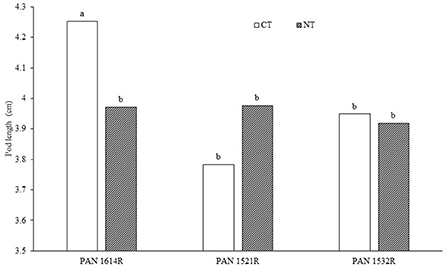
Figure 2. Interactive effects of cultivar and tillage on pod length on a soybean cropping system. Levels with same letter are not significantly different.
The increase in NPP and plant height after P application was because phosphorus in soybean is responsible for growth and pod formation (Fageria et al., 2013; Ahiabor et al., 2014). The recommended P level in the soil for soybean is between 15 and 18 mg/kg (FERTASA, 2016), and in this experiment, soils under control (0 kg/ha P) had critically low soil available P of about 11.05 mg/kg (Table 7) hence shorter plants and lower pods count. This is because low supply of P imposes major restrictions in vegetative growth and reproduction of soybean (Mitran et al., 2018). Results from Malik et al. (2006) also support these findings.
The differences in cultivar performance for 100-seed weight and plant height could be a result of genotype. This is because seed size traits are determined by several genes in a plant (Krisnawati and Adie, 2015), and mature seed sizes are simultaneously determined by embryo, cytoplasm and maternal effects (Adie and Krisnawati, 2018). Similar to 100-seed mass, plant height and the differences in pod length as a result of cultivar and tillage effects could be because of the seed genotype (Krisnawati and Adie, 2015), and adaptability to tillage system.
Significant interactions (P < 0.05) between fertilizer and tillage treatments were observed on dry biomass (Figure 3). Dry biomass was significantly higher at 30 kg/ha P under NT and statistically same with 60 kg/ha P under CT. Increase of biomass after P applications have been noted by other authors (Aulakh et al., 2003; Ahiabor et al., 2014). The response of dry biomass to P additions could be attributed to increased phosphates in the soil, which make orthophosphates readily available for plant uptake and are used for various essential plant processes such as growth, development and reproduction (Shen et al., 2011). Furthermore, no-till retains soils moisture and reduces erosion, which enhances P availability and OM decomposition under NT recycles organic P back into the soil (Busari et al., 2015).
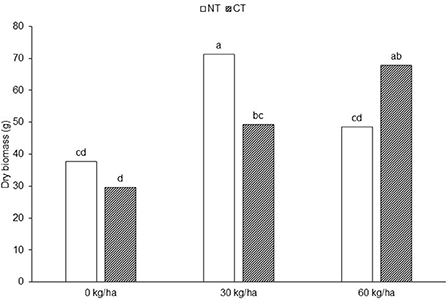
Figure 3. Interactive effects of fertilizer and tillage on dry biomass on a soybean cropping system. Levels with same letter are not significantly different.
There were statistically significant interactions between P application rate, cultivar and tillage on soybean yield (Figure 4). The overall highest yield was recorded at 30 kg/ha P application under NT for PAN 1521R, however it was statistically similar to PAN 1521R under CT at 60 kg/ha and PAN 1532R under NT at 60 kg/ha P. Nonetheless, PAN 1532 performed statically same at 60 kg/ha under NT and 30 kg/ha under both NT and CT. Therefore, the optimum fertilizer rate and tillage system for all 3 cultivars was 30 kg/ha P under NT. Yield increases after P application are expected because P is the most essential element required for growth and reproduction in soybean (Chien et al., 2011; Shen et al., 2011). Phosphorus additions result in improved yields and better grain quality (Malik et al., 2006; Mabapa et al., 2010). This is shown by positive relationship (P < 0.0001, R2 = 0.93) between soybean yield and plant P uptake (Figure 5).
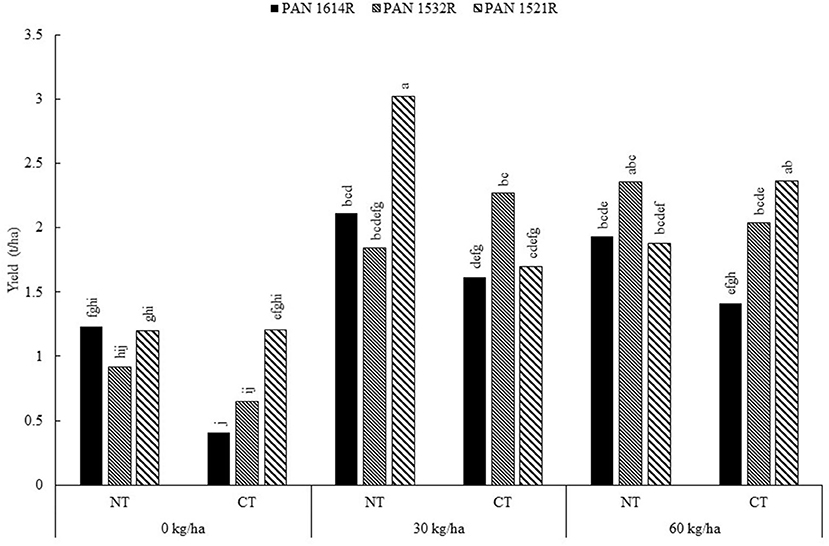
Figure 4. Interactive effects of fertilizer, cultivar and tillage on soybean yield on a soybean cropping system. Levels with same letter are not significantly different.
Nonetheless, the statistically similar yield performance of PAN 1521R at 30 kg/ha P under NT, PAN 1532R at 60 kg/ha P under NT and PAN 1521R at 60 kg/ha P under CT could be because crops usually take up to 25% of the applied phosphorus in the soil (Roberts and Johnston, 2015). Therefore, adding more fertilizer may only raise the soil's P balance where no direct yield response is expected (Chien et al., 2011). Abbasi et al. (2012), reported yield increases of up to 53% with increased P application, and Malik et al. (2006) observed a statistically similar soybean yield between 90 and 120 kg/ha. Moreover, Aulakh et al. (2003) also observed increasing seed yield following P application up to 80 kg/ha, and no yield response above 80 kg/ha P rate. As for tillage, Buah et al. (2017) noted an increasing yield of soybean by up to 54% under NT as compared to CT in 2014 on a study in Ghana. Yield increases under no-till can be attributed to improved nutrient cycling through the P release by crop residues, mineralization of OM by microorganisms (Turan et al., 2017; Zhu et al., 2018), improved infiltration and storage of water, and conservation P by reducing erosion (Jabro et al., 2011; Busari et al., 2015). Yield increases under no-till especially during drier periods were reported (Busari et al., 2015).
Yield increase at 30 and 60 kg/ha P treatments resulting from increased NPP was also recorded in this study and supported by significant positive correlation of yield with NPP (P = 0.0084; R2 = 0.90) (Figure 5).
Significant effects (P < 0.05) of phosphorus application rate and cultivar were observed on protein and oil content (Table 8). P application at 30 and 60 kg/ha significantly reduced oil content by 7.97 and 12.17% but had inverse effects on protein content increasing it by 0.92 and 1.15%, respectively, over control. These results confirm findings by several authors of decreasing oil production with increasing protein content due to P application (Mokoena, 2013; Yin et al., 2016), and statistically similar protein content between P application rates (Abbasi et al., 2012). Nonetheless, the response of oil and protein content to P application have contrasting reports in literature. Some authors have reported a decrease of protein content with no significant difference in oil content following P fertilization (Win et al., 2010), whilst others have reported an increase of both oil and protein content following P application (Malik et al., 2006; Abbasi et al., 2012). However, when P is deficient in the soil, P additions improve N fixation which enhances seed protein content (Yin et al., 2016). Phosphorus is necessary for growth, development, yield and nutritive quality of soybean seed, however, excess applications may depress oil and protein content (Win et al., 2010).
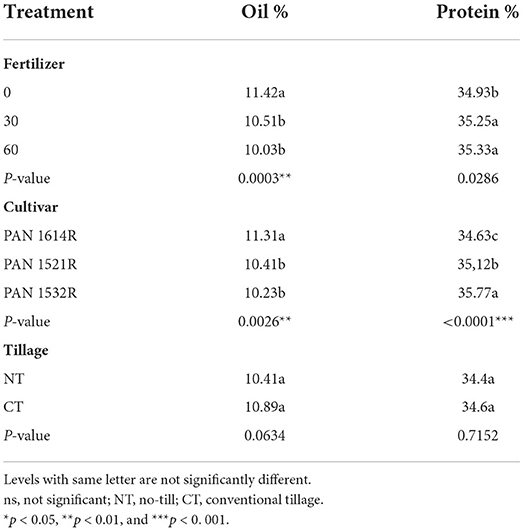
Table 8. Effects of fertilizer, cultivar and tillage on oil and protein content on a soybean cropping system.
Cultivar also had significant effects (P < 0.05) on both oil and protein content. PAN 1614R had much higher oil of up to 11.31% as compared to other cultivars, but the same cultivar had the lowest protein content of 34.63%. Contrastingly, PAN 1532R had the lowest oil content of 10.23% and the highest protein content of 35.77%. Nonetheless, correlation between oil and protein content was not significant, and this is supported by Yin et al. (2016). Other factors affecting soybean protein and oil content are genotype and the environment (Yin et al., 2016). The cultivar effect on oil and protein content could be due to 100-seed weight. It was observed that the cultivar with significantly higher 100 seed weight (PAN 1614R) contained significantly high oil and low protein content. Whereas the cultivar with significantly low 100 seed weight (PAN 1532R), the opposite is true. A positive linear relationship between oil and 100 seed weight (P = 0.0458; R2 = 0.97), and a negative linear relationship between 100-seed weight and protein (P = 0.002; R2 = 0.94) support these findings.
Conclusion and recommendations
This study showed that the application of mineral P fertilizer improved the soil's nutrients status by raising the soil's pH and also concentrations of exchangeable Ca, Mg, P, K, and TN whilst reducing Fe which is one of the main causes of soil acidity. The increase of pH with increasing exchangeable Ca and Mg under no-till supports the theory of nutrient cycling under no-till and suggest that this system could be a viable option of managing acidity considering that accessibility of lime to smallholder farmers in South Africa is a big challenge. However, this cannot match the benefits of lime application. Moreover, results of this study supports studies that indicate that penetration resistance responds very quickly to change, and that increase in biomass could improve penetration resistance in short-term experiments. Phosphorus application also stimulated activities of both ACP and ALK, with ACP being the dominant enzyme because of acidity. Nonetheless, excessive application of P above 30 kg/ha did not improve activities of both enzymes. The activities of both phosphatases increased under no-till at all growth stages, although only ACP at reproductive stage was significant. This suggest that no-till has the potential for higher enzyme activity, which would lead to increased soil fertility because of their role in solubilizing organic P.
Tillage, cultivar and varying mineral P levels had significant effects on P uptake and P use efficiency in a soybean experiment. The application of P significantly improved N, P, and K uptake at both 30 and 60 kg/ha P, however, no differences were observed between 30 and 60 kg/ha P rates for P and K. The lowest N, P, and K uptake was observed under control (0 kg/ha P), this indicates the need for P application and its conservation in soybean production. Phosphorus utilization efficiency was very low and did not differ statistically across P rates. This may be an indication of a higher fixation capacity of the soil due to acidity. Nonetheless, the PFP which calculates P efficiency using seed yield was significantly higher at 30 kg/ha P. This implies that farmers should apply fertilizers at standard rates, as excess P is agronomically inefficient.
Data availability statement
The raw data supporting the conclusions of this article will be made available by the authors, without undue reservation.
Author contributions
PC: conceptualization, methodology, formal analysis, data collection, and writing—original draft. AN: conceptualization, methodology, writing—review and editing, project administration, and supervision. IW and FM: review and editing and supervision. SM, MM and IK: review and editing and funding. All authors contributed to the article and approved the submitted version.
Funding
This work was funded by the Department of Agriculture, Land Reform and Rural Development (DALRRD), Pretoria, South Africa.
Conflict of interest
The authors declare that the research was conducted in the absence of any commercial or financial relationships that could be construed as a potential conflict of interest.
Publisher's note
All claims expressed in this article are solely those of the authors and do not necessarily represent those of their affiliated organizations, or those of the publisher, the editors and the reviewers. Any product that may be evaluated in this article, or claim that may be made by its manufacturer, is not guaranteed or endorsed by the publisher.
References
Abbasi, M. K., Manzoor, M., and Tahir, M. M. (2010). Efficiency of rhizobium inoculation and P fertilization in enhancing nodulation, seed yield, and phosphorus use efficiency by field grown soybean under hilly region of Rawalakot Azad Jammu and Kashmir, Pakistan. J. Plant Nutr. 33, 1080–1102. doi: 10.1080/01904161003729782
Abbasi, M. K., Tahir, M. M., Azam, W., Abbas, Z., and Rahim, N. (2012). Soybean yield and chemical composition in response to phosphorus–potassium nutrition in Kashmir. Agron. J. 104, 1476–1484. doi: 10.2134/agronj2011.0379
Adie, M. M., and Krisnawati, A. (2018). Identification of soybean genotypes adaptive to tropical area and suitable for industry. In IOP Conference Series. Earth Environ Sci. 102, 012045. doi: 10.1088/1755-1315/102/1/012045
Ahiabor, B. D. K., Lamptey, S., Yeboah, S., and Bahari, V. (2014). Application of phosphorus fertilizer on soybean [(Glycine Max L. (Merril)] inoculated with rhizobium and its economic implication to farmers. Am. J. Exp. Agric. 4, 1420–34. doi: 10.9734/AJEA/2014/10400
Aniekwe, N. L., and Mbah, B. N. (2014). Growth and yield responses of soybean varieties to different soil fertility management practices in Abakaliki, Southeastern Nigeria. Eur. J. Agric. Forest. Res. 2, 12–31.
Aulakh, M. S., Pasricha, N. S., and Bahl, G. S. (2003). Phosphorus fertilizer response in an irrigated soybean–wheat production system on a subtropical, semiarid soil. Field Crops Res. 80, 99–109. doi: 10.1016/S0378-4290(02)00172-7
Balota, E. L., Kanashiro, M., Colozzi Filho, A., Andrade, D. S., and Dick, R. P. (2004). Soil enzyme activities under long-term tillage and crop rotation systems in subtropical agro-ecosystems. Brazil. J. Microbiol. 35, 300–306. doi: 10.1590/S1517-83822004000300006
Bogunovic, I., Kovács, P. G., Dekemati, I., Kisic, I., Balla, I., and Birkás, M. (2019). Long-term effect of soil conservation tillage on soil water content, penetration resistance, crumb ratio and crusted area. Plant Soil Environ. 65, 442–448. doi: 10.17221/249/2019-PSE
Bonin, C., and Lal, R. (2012). Physical properties of an Alfisol under biofuel crops in Ohio. J. Technol. Innovations Renew. Energy 1, 1–13.
Bowles, T. M., Acosta-Martínez, V., Calderón, F., and Jackson, L. E. (2014). Soil enzyme activities, microbial communities, and carbon and nitrogen availability in organic agroecosystems across an intensively-managed agricultural landscape. Soil Biol. Biochem. 68, 252–262. doi: 10.1016/j.soilbio.2013.10.004
Buah, S. S. J., Ibrahim, H., Derigubah, M., Kuzie, M., Segtaa, J. V., Bayala, J., et al. (2017). Tillage and fertilizer effect on maize and soybean yields in the Guinea savanna zone of Ghana. Agric. Food Secur. 6, 1–11. doi: 10.1186/s40066-017-0094-8
Busari, M. A., Kukal, S. S., Kaur, A., Bhatt, R., and Dulazi, A. A. (2015). Conservation tillage impacts on soil, crop and the environment. Int. Soil Water Conserv. Res. 3, 119–129. doi: 10.1016/j.iswcr.2015.05.002
Chen, Y., Liu, J., and Liu, S. (2018). Effect of long-term mineral fertilizer application on soil enzyme activities and bacterial community composition. Plant Soil Environ. 64, 571–577. doi: 10.17221/658/2018-PSE
Chien, S. H., Prochnow, L. I., Tu, S., and Snyder, C. S. (2011). Agronomic and environmental aspects of phosphate fertilizers varying in source and solubility: an update review. Nutr. Cycl. Agroecosyst. 89, 229–255. doi: 10.1007/s10705-010-9390-4
DALRRD (2020). Soybean Market Value Chain Profile. Pretoria: Department of Agriculture, Land Reform and Rural Development.
Dalshad, A. D., Pakhshan, M. M., and Shireen, A. A. (2013). Effect of phosphorus fertilizers on growth and physiological phosphorus use efficiency of three soy bean cultivars. J. Vert. Agric. Sci. 3, 32. doi: 10.9790/2380-0363236
Dlamini, T. S., Tshabalala, P., and Mutengwa, T. (2013). Oil crops and and supply chain in Africa. Soybeans Prod. South Afr. 21, 1–11. doi: 10.1051/ocl/2013047
Fageria, N. K., and Baligar, V. C. (2005). Enhancing nitrogen use efficiency in crop plants. Adv. Agron. 88, 97-185.
Fageria, N. K., Moreira, A., and Dos Santos, A. B. (2013). Phosphorus uptake and use efficiency in field crops. J. Plant Nutr. 36, 2013–2022. doi: 10.1080/01904167.2013.816728
Fageria, V. D. (2001). Nutrient interactions in crop plants. J. Plant Nutr. 24, 1269–1290. doi: 10.1081/PLN-100106981
FERTASA (2016). Fertilizer Handbook, seventh revised edition. Pretoria: Fertilizer Association of Southern Africa.
Garland, G., Bünemann, E. K., Oberson, A., Frossard, E., Snapp, S., Chikowo, R., et al. (2018). Phosphorus cycling within soil aggregate fractions of a highly weathered tropical soil: a conceptual model. Soil Biol. Biochem. 116, 91–98. doi: 10.1016/j.soilbio.2017.10.007
Grant, C., Bittman, S., Montreal, M., Plenchette, C., and Morel, C. (2005). Soil and fertilizer phosphorus: effects on plant P supply and mycorrhizal development. Can. J. Plant Sci. 85, 3–14. doi: 10.4141/P03-182
Hasan, M., Teixeira da Silva, J. A., and Li, X. (2016). Regulation of phosphorus uptake and utilization: transitioning from current knowledge to practical strategies. Cell. Mol. Biol. Lett. 21, 1–19. doi: 10.1186/s11658-016-0008-y
Heidari, G., Mohammadi, K., and Sohrabi, Y. (2016). Responses of soil microbial biomass and enzyme activities to tillage and fertilization systems in soybean (Glycine max L.) production. Front. Plant Sci. 7, 1730. doi: 10.3389/fpls.2016.01730
Heuer, S., Gaxiola, R., Schilling, R., Herrera-Estrella, L., López-Arredondo, D., Wissuwa, M., et al. (2017). Improving phosphorus use efficiency: a complex trait with emerging opportunities. Plant J. 90, 868–885. doi: 10.1111/tpj.13423
Jabro, J. D., Sainju, U. M., Lenssen, A. W., and Evans, R. G. (2011). Tillage effects on dryland soil physical properties in northeastern Montana. Commun. Soil Sci Plant Anal. 42, 2179–2187. doi: 10.1080/00103624.2011.602449
Khojely, D. M., Ibrahim, S. E., Sapey, E., and Han, T. (2018). History, current status, and prospects of soybean production and research in sub-Saharan Africa. Crop J. 6, 226–235. doi: 10.1016/j.cj.2018.03.006
Kolawole, G. O. (2012). Effect of phosphorus fertilizer application on the performance of maize/soybean intercrop in the southern Guinea savanna of Nigeria. Arch. Agron. Soil Sci. 58, 189–198. doi: 10.1080/03650340.2010.512723
Krisnawati, A., and Adie, M. M. (2015). Selection of soybean genotypes by seed size and its prospects for industrial raw material in Indonesia. Proc. Food Sci. 3, 355–363. doi: 10.1016/j.profoo.2015.01.039
Lee, T., Tran, A., Hansen, J., and Ash, M. (2016). Major Factors Affecting Global Soybean and Products Trade Projections (No. 1490-2016-128405).
Lemanowicz, J., Bartkowiak, A., and Breza-Boruta, B. (2016). Changes in phosphorus content, phosphatase activity and some physicochemical and microbiological parameters of soil within the range of impact of illegal dumping sites in Bydgoszcz (Poland). Environ. Earth Sci. 75, 1–14. doi: 10.1007/s12665-015-5162-4
Liu, A., Contador, C. A., Fan, K., and Lam, H. M. (2018). Interaction and regulation of carbon, nitrogen, and phosphorus metabolisms in root nodules of legumes. Front. Plant Sci. 9, 1860. doi: 10.3389/fpls.2018.01860
Mabapa, P. M., Ogola, J. B., Odhiambo, J. J., Whitbread, A., and Hargreaves, J. (2010). Effect of phosphorus fertilizer rates on growth and yield of three soybean (Glycine max) cultivars in Limpopo Province. Afr. J. Agric. Res. 5, 2653–2660.
Malecka, I., Blecharczyk, A., Sawinska, Z., and Dobrzeniecki, T. (2012). The effect of various long-term tillage systems on soil properties and spring barley yield. Turk. J. Agric. Forest. 36, 217–226. doi: 10.3906/tar-1104-20
Malik, M. A., Cheema, M. A., Khan, H. Z., and Wahid, M. A. (2006). Growth and yield response of soybean (Glycine max L.) to seed inoculation and varying phosphorus levels. J. Agric. Res. 44, 47–53.
Mall, R. K., Gupta, A., and Sonkar, G. (2017). “Effect of climate change on agricultural crops,” in Current Developments in Biotechnology and Bioengineering, eds S. K. Dubey, A.Pandey, and R. S. Sangwan (Amsterdam: Elsevier), 23–46.
Menezes-Blackburn, D., Giles, C., Darch, T., George, T. S., Blackwell, M., Stutter, M., et al. (2018). Opportunities for mobilizing recalcitrant phosphorus from agricultural soils: a review. Plant Soil 427, 5–16. doi: 10.1007/s11104-017-3362-2
Mitran, T., Meena, R. S., Lal, R., Layek, J., Kumar, S., and Datta, R. (2018). “Role of soil phosphorus on legume production,” in Legumes for Soil Health and Sustainable Management, eds R. S. Meena, A. Das, G. S. Yadav, and R. Lal (Singapore: Springer), 487–510.
Mohammadi, K. (2011). Effect of different fertilization methods on soil biological indexes. Int. J. Agric. Biosyst. Eng. 5, 29–332. doi: 10.5281/zenodo.1058613
Mohanty, M., Sinha, N. K., McDermid, S. P., Chaudhary, R. S., Reddy, K. S., Hati, K. M., et al. (2017). Climate change impacts vis-a-vis productivity of soybean in vertisol of Madhya Pradesh. J. Agrometeorol. 19, 10–16. doi: 10.54386/jam.v19i1.749
Mokoena, T. Z. (2013). The effect of direct phosphorus and potassium fertilization on soybean (Glycine max L.) yield and quality (Doctoral dissertation). University of Pretoria, Pretoria, South Africa.
Moraru, P. I., and Rusu, T. (2013). Effect of different tillage systems on soil properties and production on wheat, maize and soybean crop. Int. J. Agric. Biosyst. Eng. 7, 1027–1030. doi: 10.5281/zenodo.1088702
Murphy, L. S., Ellis, R. Jr., and Adriano, D. C. (1981). Phosphorus-micronutrient interaction effects on crop production. J. Plant Nutr. 3, 593–613. doi: 10.1080/01904168109362863
Nziguheba, G., Zingore, S., Kihara, J., Merckx, R., Njoroge, S., Otinga, A., et al. (2016). Phosphorus in smallholder farming systems of sub-Saharan Africa: implications for agricultural intensification. Nutr. Cycl. Agroecosyst. 104, 321–340. doi: 10.1007/s10705-015-9729-y
Okalebo, J. R., Gathua, K. W., and Woomer, P. L. (2002). Laboratory methods of soil and plant analysis: a working manual second edition. Sacred Africa Nairobi 21, 25–26.
Owen, D., Williams, A. P., Griffith, G. W., and Withers, P. J. A. (2015). Use of commercial bio-inoculants to increase agricultural production through improved phosphrous acquisition. Appl. Soil Ecol. 86, 41–54. doi: 10.1016/j.apsoil.2014.09.012
Phiri, A. T., Muindi, E. M., Omollo, J. O., Yegon, R., and Kausiwa, D. (2016). Inoculated soybean yields response to nitrogen and phosphorus application. Int. J. Plant Soil Sci. 10, 1–7. doi: 10.9734/IJPSS/2016/24905
Piotrowska-Dlugosz, A., and Wilczewski, E. (2014). Soil phosphatase activity and phosphorus content as influenced by catch crops cultivated as green manure. Polish J. Environ. Stud. 23, 157–165.
Raliya, R., Tarafdar, J. C., and Biswas, P. (2016). Enhancing the mobilization of native phosphorus in the mung bean rhizosphere using ZnO nanoparticles synthesized by soil fungi. J. Agric. Food Chem. 64, 3111–3118. doi: 10.1021/acs.jafc.5b05224
Ramesh, A., Sharma, S. K., Yadav, N., and Joshi, O. P. (2014). Phosphorus mobilization from native soil P-pool upon inoculation with phytate-mineralizing and phosphate-solubilizing Bacillus aryabhattai isolates for improved P-acquisition and growth of soybean and wheat crops in microcosm conditions. Agric. Res. 3, 118–127. doi: 10.1007/s40003-014-0105-y
Ramirez, B.S., and Ramírez, J.G. (2018). Douglas Montgomery's Introduction to Statistical Quality Control: A JMP Companion. Sas Institute.
Rincon-Florez, V. A., Dang, Y. P., Crawford, M. H., Schenk, P. M., and Carvalhais, L. C. (2016). Occasional tillage has no effect on soil microbial biomass, activity and composition in Vertisols under long-term no-till. Biol. Fertil. Soils 52, 191–202. doi: 10.1007/s00374-015-1066-4
Roberts, T. L., and Johnston, A. (2015). Phosphorus use efficiency and management in agriculture. Resour. Conserv. Recycl. 105, 275–81. doi: 10.1016/j.resconrec.2015.09.013
Ronner, E., Franke, A. C., Vanlauwe, B., Dianda, M., Edeh, E., Ukem, B., et al. (2016). Understanding variability in soybean yield and response to P-fertilizer and rhizobium inoculants on farmers' fields in northern Nigeria. Field Crops Res. 186, 133–145. doi: 10.1016/j.fcr.2015.10.023
Satyaprakash, M., Nikitha, T., Reddi, E. U. B., Sadhana, B., and Vani, S. S. (2017). Phosphorous and phosphate solubilising bacteria and their role in plant nutrition. Int. J. Curr. Microbiol. Appl. Sci. 6, 2133–2144. doi: 10.20546/ijcmas.2017.604.251
Shanker, L. K., and Shailendra, S. (2014). Growth, productivity and quality of soybean [Glycine max (L) Merrill) under different levels and sources of phosphorus and plant growth regulators in sub humid Rajasthan. Afr. J. Agric. Res. 9, 1045–1051. doi: 10.5897/AJAR2013.8328
Sharma, P., Abrol, V., Sharma, K. R., Sharma, N., Phogat, V. K., and Vikas, V. (2016). Impact of conservation tillage on soil organic carbon and physical properties–a review. Int. J. Bio-resour. Stress Manag. 7, 151–161. doi: 10.23910/IJBSM/2016.7.1.1387
Sharma, S. B., Sayyed, R. Z., Trivedi, M. H., and Gobi, T. A. (2013). Phosphate solubilizing microbes: sustainable approach for managing phosphorus deficiency in agricultural soils. SpringerPlus 2, 1–14. doi: 10.1186/2193-1801-2-587
Sharma, U. C., Datta, M., and Sharma, V. (2011). Effect of applied phosphorus on the yield and nutrient uptake by soybean cultivars on acidic hill soil. Open J. Soil Sci. 1, 45–48. doi: 10.4236/ojss.2011.12006
Shen, J., Yuan, L., Zhang, J., Li, H., Bai, Z., Chen, X., et al. (2011). Phosphorus dynamics: from soil to plant. Plant Physiol. 156, 997–1005. doi: 10.1104/pp.111.175232
Sithole, N. J., Magwaza, L. S., and Mafongoya, P. L. (2016). Conservation agriculture and its impact on soil quality and maize yield: a South African perspective. Soil Tillage Res. 162, 55–67. doi: 10.1016/j.still.2016.04.014
SSSSA. Non-Affiliated Soil Analysis Work Committee (1990). Handbook of Standard Soil Testing Methods for Advisory Purposes. Pretoria: Soil Science Society of South Africa, 160
Syers, J. K., Johnston, A. E., and Curtin, D. (2008). Efficiency of soil and fertilizer phosphorus use. FAO Fertil. Plant Nutr. Bull. 18.
Tabatabai, M. A. (1994). “Soil enzymes,” in Methods of Soil Analysis: Part 2 Microbiological and Biochemical Properties (Madison, WI: Soil Science Society of America), 775–833.
Turan, M., Nikerel, E., Kaya, K., Kitir, N., Gunes, A., Mokhtari, N. E. P., et al. (2017). “Enzyme dynamic in plant nutrition uptake and plant nutrition,” in Enzyme Inhibitors and Activators, ed M. Senturk (London: IntechOpen). doi: 10.5772/66938
van de Wiel, C., van der Linden, C. G., and Scholten, O. E. (2016). Improving phosphorus use efficiency in agriculture: opportunities for breeding. Euphytica 207, 1–22. doi: 10.1007/s10681-015-1572-3
Verde, B.S., Danga, B.O., and Mugwe, J.N. (2013). The Effects of Manure, Lime and P Fertilizer on N Uptake and Yields of Soybean (Glycine max (L.) Merrill) in the Central Highlands of Kenya. J. Environ. Sci. Eng. 2:111.
Villamil, M. B., Little, J., and Nafziger, E. D. (2015). Corn residue, tillage, and nitrogen rate effects on soil properties. Soil Till. Res. 151, 61–66. doi: 10.1016/j.still.2015.03.005
Vukicevich, E., Lowery, T., Bowen, P., Úrbez-Torres, J. R., and Hart, M. (2016). Cover crops to increase soil microbial diversity and mitigate decline in perennial agriculture. A review. Agron. Sustain. Dev. 36, 1–14. doi: 10.1007/s13593-016-0385-7
Wang, S., Liang, X., Liu, G., Li, H., Liu, X., Fan, F., et al. (2013). Phosphorus loss potential and phosphatase activities in paddy soils. Plant Soil Environ. 59, 530–536. doi: 10.17221/626/2013-PSE
Win, M., Nakasathien, S., and Sarobol, E. (2010). Effects of phosphorus on seed oil and protein contents and phosphorus use efficiency in some soybean varieties. Agricul. Nat. Resour. 44, 1–9.
Yan, X., Yang, W., Chen, X., Wang, M., Wang, W., Ye, D., et al. (2020). Soil phosphorus pools, bioavailability and environmental risk in response to the phosphorus supply in the red soil of Southern China. Int. J. Environ. Res. Public Health 17, 7384. doi: 10.3390/ijerph17207384
Yin, X., Bellaloui, N., McClure, A. M., Tyler, D. D., and Mengistu, A. (2016). Phosphorus fertilization differentially influences fatty acids, protein, and oil in soybean. Am. J. Plant Sci. 7, 1975–1992. doi: 10.4236/ajps.2016.714180
Zhang, X., Dong, W., Dai, X., Schaeffer, S., Yang, F., Radosevich, M., et al. (2015). Responses of absolute and specific soil enzyme activities to long term additions of organic and mineral fertilizer. Sci. Total Environ. 536, 59–67. doi: 10.1016/j.scitotenv.2015.07.043
Zheng, H., Chen, L., Han, X., Ma, Y., and Zhao, X. (2010). Effectiveness of phosphorus application in improving regional soybean yields under drought stress: A multivariate regression tree analysis. Afr. J. Agric. Res. 5, 3251–3258.
Keywords: phosphorus, no-till, P use efficiency, soybean, smallholder farmers, alkaline phosphatase, acid phosphatase, yield
Citation: Chauke PB, Nciizah AD, Wakindiki IIC, Mudau FN, Madikiza S, Motsepe M and Kgakatsi I (2022) No-till improves selected soil properties, phosphorous availability and utilization efficiency, and soybean yield on some smallholder farms in South Africa. Front. Sustain. Food Syst. 6:1009202. doi: 10.3389/fsufs.2022.1009202
Received: 01 August 2022; Accepted: 22 September 2022;
Published: 18 October 2022.
Edited by:
Cosmas Parwada, Zimbabwe Open University, ZimbabweReviewed by:
Akinson Tumbure, Marondera University of Agricultural Sciences and Technology (MUAST), ZimbabwePhillip Nyamugafata, University of Zimbabwe, Zimbabwe
Copyright © 2022 Chauke, Nciizah, Wakindiki, Mudau, Madikiza, Motsepe and Kgakatsi. This is an open-access article distributed under the terms of the Creative Commons Attribution License (CC BY). The use, distribution or reproduction in other forums is permitted, provided the original author(s) and the copyright owner(s) are credited and that the original publication in this journal is cited, in accordance with accepted academic practice. No use, distribution or reproduction is permitted which does not comply with these terms.
*Correspondence: Adornis D. Nciizah, bmNpaXphaGFAYXJjLmFncmljLnph
 Patience B. Chauke
Patience B. Chauke Adornis D. Nciizah
Adornis D. Nciizah Isaiah I. C. Wakindiki2,3
Isaiah I. C. Wakindiki2,3 Fhatuwani N. Mudau
Fhatuwani N. Mudau